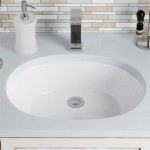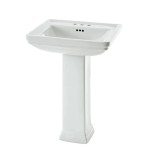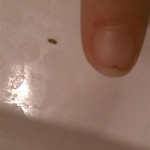How To Take The Drain Out Of A Bathroom Sink
Removing a bathroom sink drain is a common plumbing task that homeowners may encounter when replacing a sink, unclogging persistent blockages, or performing general maintenance. While seemingly straightforward, this process requires a methodical approach and a basic understanding of plumbing components to avoid damaging the sink, pipes, or creating leaks. This article provides a comprehensive guide on how to safely and effectively remove a bathroom sink drain.
Before commencing, it is crucial to gather the necessary tools and materials. These typically include:
*Adjustable wrench: For loosening and tightening nuts and bolts.
*Channel-lock pliers: For gripping and turning larger components.
*Penetrating oil: To loosen corroded or stuck parts.
*Basin wrench (sink wrench): A specialized tool for accessing hard-to-reach nuts under the sink.
*Bucket or container: To catch water and debris.
*Old towels or rags: To protect surfaces and clean up spills.
*Safety glasses: To protect eyes from debris.
*Gloves: To protect hands.
*Screwdriver (Phillips and flathead): Depending on the drain assembly.
Step 1: Preparation and Shut-Off
The first and most important step is to shut off the water supply to the sink. Locate the shut-off valves under the sink, typically one for hot water and one for cold water. Turn both valves clockwise until they are completely closed. To verify that the water is indeed shut off, turn on the faucet briefly. If no water flows, the valves are properly closed. If water continues to flow, the shut-off valves may be faulty and require replacement before proceeding. In this case, locate the main water shut-off valve for the entire house and turn it off.
Once the water supply is secured, place a bucket or container under the drain assembly to catch any residual water that may be trapped in the pipes. Protect the surrounding floor area with old towels or rags to prevent water damage. Clear the area under the sink to provide adequate working space. This will allow for easier maneuvering and prevent accidental bumps or damage to other plumbing components.
Examine the drain assembly to understand its configuration. Most bathroom sink drains consist of several key components: the sink flange (the metal piece visible in the sink), the drain body (the threaded pipe connecting the flange to the P-trap), the P-trap (the curved pipe that traps debris and prevents sewer gases from entering the bathroom), the tailpiece (the pipe connecting the P-trap to the drain body), the pop-up drain assembly (if present), and various nuts and washers that secure these components together. Understanding the function of each component will facilitate the disassembly process.
Step 2: Disconnecting the Pop-Up Drain Assembly (If Applicable)
Many bathroom sinks are equipped with a pop-up drain, which allows the user to open and close the drain stopper with a lever. Before attempting to remove the drain body, it is essential to disconnect the pop-up drain assembly.
Locate the horizontal rod that extends from the pop-up drain assembly to the pivot rod under the sink. This rod is typically held in place by a spring clip or a retaining nut. Remove the spring clip or loosen the retaining nut to detach the horizontal rod from the pivot rod. Once the horizontal rod is disconnected, carefully remove the pivot rod from the drain body. Some pivot rods may be held in place by a nut; loosen the nut and gently pull the rod out.
After removing the pivot rod, the pop-up drain stopper can be lifted out of the sink drain. Be prepared for some water and debris to drain out when the stopper is removed. Clean the stopper and set it aside. The pop-up drain assembly is now disconnected from the drain body, allowing for further disassembly.
Step 3: Loosening and Removing the Drain Body
With the water shut off and the pop-up drain assembly disconnected, the next step is to loosen and remove the drain body from the sink. This involves disconnecting the drain body from the P-trap and then unscrewing the retaining nut that secures the drain flange to the sink.
Start by loosening the slip nuts that connect the P-trap to the tailpiece and the drain outlet pipe. Use channel-lock pliers or an adjustable wrench to loosen these nuts, turning them counterclockwise. Be prepared for residual water to drain out when the connections are loosened. Once the slip nuts are sufficiently loosened, carefully detach the P-trap from the tailpiece and the drain outlet pipe. Set the P-trap aside, as it will likely need to be cleaned before reinstallation.
The next step is to loosen the large retaining nut that secures the drain flange to the sink. This nut is typically located under the sink, directly beneath the drain flange. Accessing this nut can be challenging due to its location and the limited space available under the sink. A basin wrench (sink wrench) is the ideal tool for this task. The basin wrench has a swiveling head that allows it to grip the nut from various angles. Position the jaws of the basin wrench around the retaining nut and turn it counterclockwise to loosen it. If the nut is corroded or stuck, applying penetrating oil can help to loosen it. Allow the penetrating oil to soak for several minutes before attempting to loosen the nut again.
Once the retaining nut is sufficiently loosened, carefully unscrew it by hand. Continue to support the drain body from below while unscrewing the nut to prevent it from falling and potentially damaging the sink. With the retaining nut completely removed, the drain body should be free to move. Gently push the drain body upwards from underneath the sink to detach the drain flange from the sink. The drain flange may be sealed to the sink with plumber’s putty or silicone sealant. Use a putty knife or a flathead screwdriver to carefully break the seal between the flange and the sink if necessary.
With the drain flange detached, carefully remove the drain body from the sink. Inspect the area around the drain opening for any remaining plumber's putty or sealant and clean it thoroughly. The old drain assembly is now completely removed from the sink.
After removing the drain, it is crucial to inspect the sink drain opening and the surrounding area for any signs of damage or corrosion. Clean the drain opening thoroughly to remove any residual debris, plumber’s putty, or sealant. Use a putty knife or a scraper to remove stubborn residue. Ensure that the drain opening is smooth and free of any imperfections that could compromise the seal of the new drain assembly.
Inspect the tailpiece and the P-trap for any signs of damage or corrosion. If these components are in good condition, clean them thoroughly with soap and water to remove any accumulated debris or grease. If the tailpiece or the P-trap are damaged or corroded, it is advisable to replace them with new components to ensure a leak-free installation.
Before installing a new drain assembly, it is important to ensure that all the necessary components are on hand and in good condition. This includes the new drain flange, drain body, retaining nut, washers, and pop-up drain assembly (if applicable). Check the manufacturer’s instructions for the new drain assembly to ensure that all the components are compatible with the sink and the existing plumbing.
When installing a new drain assembly, it is essential to apply a fresh layer of plumber’s putty or silicone sealant to the underside of the drain flange. This will create a watertight seal between the flange and the sink, preventing leaks. Roll the plumber’s putty into a rope-like shape and press it firmly against the underside of the flange, ensuring that it completely covers the contact area.
Carefully insert the new drain flange into the sink drain opening, ensuring that it is properly centered and aligned. From underneath the sink, thread the retaining nut onto the drain body, ensuring that the washers are properly positioned. Tighten the retaining nut by hand until it is snug, then use a basin wrench to tighten it further. Avoid over-tightening the nut, as this could damage the sink or the drain assembly.
Reconnect the P-trap to the tailpiece and the drain outlet pipe, ensuring that the slip nuts are properly tightened. Reinstall the pop-up drain assembly, connecting the horizontal rod to the pivot rod and securing it with the spring clip or retaining nut. Verify that the pop-up drain stopper functions properly and that there are no leaks.
Step 4: Testing for Leaks
After reassembling the drain, it is crucial to test for leaks before declaring the job complete. Turn on the water supply slowly, starting with a small trickle and gradually increasing the flow. Carefully inspect all the connections for any signs of leaks. Pay particular attention to the drain flange, the retaining nut, the slip nuts on the P-trap, and the pop-up drain assembly.
If any leaks are detected, immediately turn off the water supply and tighten the affected connections. If tightening the connections does not eliminate the leaks, disassemble the leaking joint and inspect the components for damage or misalignment. Reapply plumber’s putty or silicone sealant as needed and reassemble the joint, ensuring that all the components are properly aligned and tightened.
Once all the leaks have been addressed, allow the water to run for several minutes to ensure that there are no hidden leaks. Check the area under the sink for any signs of moisture. If no leaks are detected, the job is complete. Clean up any spills or debris and dispose of the old drain assembly and any used materials.
Should issues arise during the drain removal or replacement process, it is prudent to consult a qualified plumber. Attempting to force components or improvising solutions can lead to further damage and more costly repairs. A professional plumber has the experience and tools to address complex plumbing issues safely and effectively.

5 Natural Ways To Unclog A Bathroom Sink Hiller How

How To Remove A Bathroom Sink Stopper Take Out Pop Up Drain From

How To Unclog A Sink The Right Way

Quick Tip 26 Pop Up Stopper Sticks Misterfix It Com

How To Clean A Clogged Sink Remove Stopper

How To Unclog A Bathroom Sink Hana S Happy Home

How To Remove A Drain From Bathroom Sink Inside Out Property Inspectors

Complete Guide Fixing A Sink Stopper Step By Instructions
How To Get A Bathroom Sink Plug Removed When It Won T Un Quora

How To Replace A Sink Stopper Quick And Simple Home Repair







